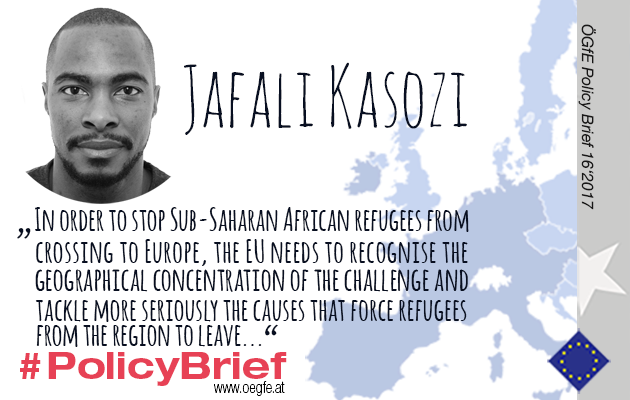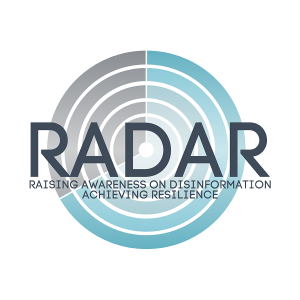Policy Recommendations
- In order to stop Sub-Saharan African refugees from crossing to Europe, the EU needs to recognise the geographical concentration of the challenge and tackle more seriously the causes that force refugees from the region to leave. Otherwise, these people will continue finding their way into the EU.
- Politicians in the EU should not use refugees as an instrument to create fear, but rather think about constructive solutions based on solidarity and humanity.
- The EU member states should stop packing refugees in camps, forcing them to wait for years without even accessing their asylum applications. Instead, more efforts should be undertaken to give them opportunities to work and contribute to growth in Europe.
Abstract
The massive inflow of refugees that the EU witnessed in 2015/2016 hit many countries by surprise. In particular, countries such as Austria, Sweden and Germany, which took in the highest numbers compared to their population, faced severe challenges. However, from a global perspective the situation in Europe only constitutes the “tip of the iceberg”. The overwhelming majority of displaced people are hosted in developing countries, either as Internally Displaced People or as refugees in countries neighbouring conflict zones. Developing countries host 13.9 million refugees under UNHCR mandate or about 86 percent of the world’s refugees. So contrary to what has been sometimes claimed in popular media, refugees are not “invading” the higher-income countries.
One region that has been dealing with particularly high numbers of refugees for a long time is Sub-Saharan Africa. Around 30 percent of global refugees are hosted by this region. Most refugees from these countries remain within the region. In fact, Sub-Saharan Africa has been hosting more refugees than sending them since 1990.
At the same time, Sub-Saharan Africans, who come to Europe, are commonly portrayed as “destitute” or “desperate”. However, they are often relatively well educated and from moderate socio-economic backgrounds. They move because of a general lack of opportunities, fear of persecution and violence, or a combination of both.
This Policy Brief wants to put things into persepective and suggests a new European approach to dealing with refugees from Sub-Saharan Africa.
****************************
The refugee crisis and the situation in Sub-Saharan Africa
The refugee situation in Sub-Saharan Africa
In 2015, around 86 percent of the world’s refugees under UNHCR mandate, meaning 13.9 million people, were hosted by developing countries.[1] With 4.4 million individuals, Sub-Saharan Africa (SSA)[2] was the region with the largest number of refugees. They originated mainly from five countries: Somalia, South Sudan, the Democratic Republic of the Congo, Sudan, and the Central African Republic. Altogether, they accounted for 3.5 million (80%) of the total refugee population residing in this region by the end of 2015.[3]
Research shows that refugees in Sub-Saharan Africa mainly remain in Africa and are not coming to Europe or other continents.
Even though, the lack of systematic bilateral data for refugees in SSA limits the possibility to concretely depict flows within the region, research shows that refugees in SSA mainly remain in Africa and are not coming to Europe or other continents. The largest share stays within the SSA countries themselves. Beyond that, there are flows from SSA to North Africa and the Middle East, but also vice versa.[4] Actually, SSA has hosted more refugees than sent since 1990. In particular, the uprisings that spread across several Arab countries from 2011 onwards (Egypt, Libya, Syria, Tunisia and Yemen) and in 2013 with large outflows of refugees from Iraq, Syria and Yemen have put pressure on the region.
Additionally to these refugees, the Internal Displacement Monitoring Centre (IDMC) estimates that there were 12.5 million Internally Displaced People (IDPs)[5] in the 21 SSA countries that IDMC monitors at the end of 2013. This also represents more than a third of the global total. The largest populations of IDPs are living in Nigeria, the Democratic Republic of the Congo and Sudan.[6]
Refugee hotspots within Sub-Saharan Africa
The highest numbers of refugees in SSA were registered in 1994. At that time, the conflicts in Central Africa and the Great Lakes as well as the Rwandan genocide caused millions of people to flee from their countries. When the situation calmed down in these countries, Eastern Africa and the Horn of Africa became the main source of refugees. They were also driving the increase over recent years. In particular, increased violence combined with extreme weather events in Somalia and North and South Sudan[7], caused many people from the region to leave their countries.[8]
Detailed numbers are missing with regard to IDPs. However, the Internal Displacement Monitoring Centre estimates that there are four countries in SSA with more than one million IDPs: the Democratic Republic of the Congo (3 million), Nigeria (3.3 million), North Sudan (2.4 million) and Somalia (1 million).[9]
Positive developments can be seen in Southern and Western Africa, where both the numbers of refugees as well as those of IDPs have strongly decreased since conflicts occurring in Angola, Sierra Leone, Liberia and Mozambique at the beginning of the 1990s have been settled or have significantly decreased in intensity.
Refugees from Sub-Saharan Africa crossing to Europe
The distraction and chaos in Libya made it possible for many migrants from SSA to cross over to Europe using overcrowded rubber boats. Most of the migrants come from Senegal, Gambia, Sierra Leone, Liberia, Mali, Côte d’Ivoire, Ghana, and Nigeria as well as the Democratic Republic of the Congo, Cameron, Sudan and the Horn of Africa.[10]
[zitat inhalt=”The distraction and chaos in Libya made it possible for many migrants from SSA to cross over to Europe using overcrowded rubber boats.”]
According to the International Organization for Migration 181,436 migrants arrived in Italy by sea in 2016, an 18 percent increase compared to 2015 and a 6 percent increase over 2014 totals. However, there seems to be a shift in the origin of migrants. While in 2014, the largest portion of migrants leaving Libya came from Syria, a population that changed its route to Greece via Turkey in 2015, in 2016 only 1,000 Syrians arrived via North Africa in Europe. This indicates an increase in arrivals from Sub-Saharan Africans.[11]
EU response
Valletta Summit
Already on 11th/12th November 2015, EU and African leaders held a summit in Valletta to find ways to address the root causes of destabilization, forced displacement and irregular migration from SSA.[12] One result of this so called Valletta Summit was the creation of the EU Emergency Trust Fund for Africa, which shall support the most fragile and affected African countries.[13] It focuses on three regions: The Sahel Region and Lake Chad, the Horn of Africa, and North Africa, comprising a total of 25 countries, including 21 SSA countries.
The Trust Fund pools money from different sources: European Commission financial instruments, resources from EU Members States as well as from Norway and Switzerland. By May 2017 the available resources have summed up to more than 2.8 billion euros.[14]
It focuses on four priority sectors: economic programmes (create employment opportunities), resilience (support basic services for local populations), migration management as well as stability and governance.
Malta Summit
As migrants from SSA were continuing to pour on the shores of Italy, EU leaders met in Malta on 3rd February 2017 to discuss further actions.[15] They adopted the Malta Declaration, which focuses on measures to stem the flow of migration from Libya to Italy.[16] It includes the following:
- training, equipment and support to the Libyan national coast guard and other relevant agencies,
- further efforts to disrupt the business model of smugglers through enhanced operational action,
- supporting where possible the development of local communities in Libya,
- seeking to ensure adequate reception capacities and conditions in Libya for migrants,
- supporting IOM in significantly stepping up assisted voluntary return activities,
- enhancing information campaigns and outreach addressed at migrants,
- helping to reduce the pressure on Libya’s land borders,
- keeping track of alternative routes and possible diversion of smugglers’ activities,
- continuing support to efforts and initiatives from individual Member States directly engaged with Libya,
- deepening dialogue and cooperation on migration with all countries neighbouring Libya.
Reflections on the Valletta and Malta Summits
To me, the EU Emergency Trust Fund for Africa is well-intentioned, but it will not be sufficient to tackle the root causes of migration. People are fleeing because of a general lack of opportunities, fear of persecution and violence, or a combination of both. The former is partly addressed by the Trust Fund, but a stronger commitment would still be needed. The latter, however, is practically not tackled at all. But many people from SSA have to leave their countries due to civil wars, terrorism and oppression. A re-allocation of resources would therefore be necessary to also tackle these issues.
With regards to the Malta Declaration, it can be seen that it clearly focuses on stopping migrants from crossing the Mediterranean from Libya to Italy. But from the perspective of a refugee I can say: Border controls and sending back people will not stop others from coming. People need peace and stability to settle home. The debate should therefore again focus more strongly on the long-term solutions to the main causes of instability.
People need peace and stability to settle home. The debate should therefore again focus more strongly on the long-term solutions to the main causes of instability.
Betts and Collier (2017) refer to the varying phases of the heartless head and the headless heart when dealing with refugees in Europe.[17] At first, it was thought that the problem will remain in SSA. Hence, limited attention as well as financial resources were allocated to the region (heartless head). With the pronunciation of “Wir schaffen das” (“We can manage that”) by Chancellor Angela Merkel the phase of the headless heart was initiated. It was morally inspiring, but led not even six months after its proclamation to another U-turn, which brought the EU again into a phase of the heartless head.
So what we need is both the heart and the head. Europe needs to be able to think about a long-term response and should not see refugees as instruments to create fear, but rather think about constructive solutions based on solidarity and humanity.
Tragedies faced by refugees from Sub-Saharan Africa in the EU
I was born and raised in Uganda and studied there at the Makerere University in Kampala. At the age of 26 I had to flee from my country, because I am gay, something that is regarded as evil, inhuman, ungodly and against the culture by both the state and the society. Therefore, I had to leave my family, my job and all that I had built up in my life. So now, I am living in Vienna, trying to re-build my life. I am glad that I have found a new family and I even got the chance to study at the University of Economics and Business, for which I am grateful. At the same time, I have now been waiting for my asylum Interview for 1 year and 10 months, still counting. Therefore, I also want to highlight some of the challenges you might face as a refugee from SSA in the EU. These include the following:
Unfair asylum system. As an asylum seeker from SSA, your asylum application is always put at the end. In Austria, for example, asylum seekers from SSA usually have to wait for more than two years to have their Interview, whereas asylum seekers from other regions in many cases need less than a year to see their process accomplished. This unfair and unjust process leads to a collapse of the system and is also an indication of the failure of the EU to manage asylum applications in a just and equal manner.
Few chances of acquiring a positive asylum decision. For SSA asylum seekers the chances of getting a negative decision (even before going to your interview) is very high, in the case of Nigerians for example at 70%.[18] There is a huge bias with regards to asylum seekers from this region and this leads to frustration. Going through an appeal process, however, is expensive. So after all that process of waiting, in most cases you end up being deported back to your country. Others have decided to commit suicide and crimes like selling drugs, since they already know that the system is biased.
Not allowed to work. According to international law host countries have to restore the shreds of normality to the disrupted life of refugees. Nevertheless, some countries are doing the opposite. They just pack people into camps and put them on hold for over ten years. This is testimony to 60 years of a false model. Refugees require more than food and beds. They need autonomy and the possibility to earn a living.
Conclusion
On the one hand, it needs to be stronger emphasized that refugees are not “invading” the higher income countries. Instead, most of them (86 percent) remain in developing countries. Stronger emphasis shall therefore be placed on supporting the people in these countries by tackling the root causes of migration. Besides economic, educational and governance projects, a stronger focus shall be placed on combatting terrorism and calming civil wars in SSA.
On the other hand, those refugees, who arrived in Europe, should be able to receive a just and timely asylum procedure. They should not be used as an instrument to create fear and to split the society, but rather be given the chance to demonstrate their talents and contribute to economic growth.
[1] UNHCR: Global Trends – Forced Displacement in 2015: http://www.unhcr.org/statistics/unhcrstats/576408cd7/unhcr-global-trends-2015.html.
[2] According to the UN, Sub-Saharan Africa consists of all African states that are fully or partially located south of the Sahara. Full list of countries: https://unstats.un.org/unsd/methodology/m49/.
[3] UNHCR: Global Trends – Forced Displacement in 2015: http://www.unhcr.org/statistics/unhcrstats/576408cd7/unhcr-global-trends-2015.html.
[4] Verwimp, P., Maystadt, J.-F. (2015): Forced Displacement and Refugees in Sub-Saharan Africa: An Economic Inquiry. World Bank Group: http://documents.worldbank.org/curated/en/546181468194940969/pdf/WPS7517.pdf.
[5] Internally Displaced People (IDPs): Persons or groups of persons who have been forced or obliged to flee or to leave their homes or places of habitual residence, in particular as a result of or in order to avoid the effects of armed conflict, situations of generalized violence, violations of human rights or natural or human-made disasters, and who have not crossed an internationally recognized State border.
[6] IDMC: Global Overview 2014: people internally displaced by conflict and violence: http://www.internal-displacement.org/publications/2014/global-overview-2014-people-internally-displaced-by-conflict-and-violence.
[7] Council on Foreign Relations: Civil War in South Sudan: http://www.cfr.org/global/global-conflict-tracker/p32137#!/conflict/civil-war-in-south-sudan.
[8] Verwimp, P., Maystadt, J.-F. (2015): Forced Displacement and Refugees in Sub-Saharan Africa: An Economic Inquiry. World Bank Group: http://documents.worldbank.org/curated/en/546181468194940969/pdf/WPS7517.pdf.
[9] IDMC: Global Overview 2014: people internally displaced by conflict and violence: http://www.internal-displacement.org/publications/2014/global-overview-2014-people-internally-displaced-by-conflict-and-violence.
[10] Voanews.com: Migrants Surge From Sub-Saharan Africa Into Italy: http://www.voanews.com/a/migrants-surge-from-sub-saharan-africa-into-italy/3264783.html.
[11]IOM: Mediterranean Migrant Arrivals Top 363,348 in 2016; Deaths at Sea: 5,079: https://www.iom.int/news/mediterranean-migrant-arrivals-top-363348-2016-deaths-sea-5079.
[12] European Council: Valletta summit on migration, 11-12 November 2015 – action plan and political declaration: http://www.consilium.europa.eu/de/press/press-releases/2015/11/12-valletta-final-docs/.
[13] EU Emergency Trust Fund for Africa: https://ec.europa.eu/europeaid/regions/africa/eu-emergency-trust-fund-africa_en.
[15] Informal meeting of EU heads of state or government, Malta, 03/02/2017: http://www.consilium.europa.eu/en/meetings/european-council/2017/02/03-informal-meeting/.
[16] Malta Declaration by the members of the European Council on the external aspects of migration: addressing the Central Mediterranean route: http://www.consilium.europa.eu/en/press/press-releases/2017/02/03-malta-declaration/
[17] Betts, A., Collier, P. (2017): Refuge: Transforming a Broken Refugee System. Penguin: Allen Lane.
[18] ESI Newsletter 3/2017: http://www.esiweb.org/pdf/index.php?lang=en&id=67&newsletter_ID=112.
About the article
ISSN 2305-2635
The views expressed in this publication are those of the author and not necessarily those of the Austrian Society of European Politics or the organisation for which the author works.
Citation
Kasozi, J. (2017). The refugee crisis and the situation in Sub-Saharan Africa. Vienna. ÖGfE Policy Brief, 16’2017







